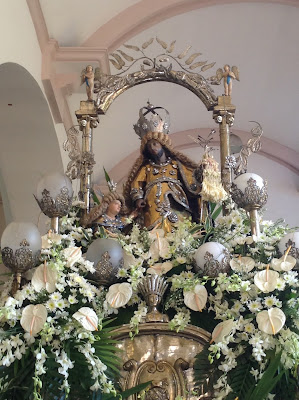San Jose de Navotas - The Miraculous Patriarch of Navotas City
 |
| San Jose de Navotas (original image) |
The image
There were two images of San Jose that is currently venerated in the parish, the centuries old original image where the de datallado image is covered with metal covering and the bigger altar image.
The first image is a detallado image of San Jose with the Child Jesus beside him. San Jose is seen holding his staff with azucenas (an allusion to his purity and to the pious tradition that when a spouse for the Virgin Mary was being selected, his staff grew lilies and it was taken as a sign that God chose him to be the husband of the Virgin who at that time serving at the temple.), while the Child Jesus holds a tool box.
Both foster father and Son wears a set of wigs and a customized plancha or metal covering to protect the images, the plancha has an intricate design that mimics an embroidered vestment which and has a hat at the back of the metal plancha - a unique feature of this kind of covering images with metal works. Another unique feature of this image is the crown placed on San Jose's head which is a rarity to any images of St. Joseph in the Philippines. The crown on St. Joseph's head stressed out the fact externally of his lineage to King David in line of the fulfillment of the prophecy of the prophets of the Old Testament that the Messiah would come from the lineage of King David. Upon close examination of the images, both San Jose and Niño Jesus have mystifying blue eyes. The stance of the image seemed hunched that devotees fondly call him as "Tata Bukot".
 |
| San Jose de Navotas (altar image) |
The Second image is the bigger altar image of San Jose de Navotas which was simpler than the original image where he is presented in the baroque style with green and yellow robes and cloak. St. Joseph also carries his diagnostic staff and the Infant Jesus whose holding a small cross and facing him tenderly. The altar image shows San Jose standing on a cloud with angels holding lilies.
The origins
The origins of the devotion to St. Joseph in Navotas dates back in 1859 with the foundation of the parish of St. Joseph in Navotas and was placed under his patronage that marked the separation of Navotas to Hacienda Tambobong (now Malabon City). The Parish of San Jose de Navotas was canonically erected on July 1, 1859. The construction of a provisional parish church started in November of the same year. It was in 1860, under the helm of Rev. Fr. Matias Naboa that the main altar was completed, the cemetery was inaugurated, and the belfry was erected. Right from the start, the parish boasted of a spacious churchyard.
 |
| San Jose de Navotas (original image) also known as "Tata Bukot" |
Several improvements have been made since the parish's establishment, such as the construction of a complete, new parish complex over the years. On June 1892, Rev. Fr. Tomas Agudo led the construction of the present–day parish, with the altar done by April 1895. At this time, the image of San Jose, along with the images of San Ildefonso and San Roque were too small for the bigger church. It was decided that a new bigger image of San Jose will be made and the smaller original image will be entrusted to a prominent family in Navotas for safekeeping and will become the processional image of the parish.
The Parish of San Jose de Navotas withstood other endeavors sturdily, from Aglipayan Schisms of the early 1900’s, the storm of October 16, 1934 that substantially damaged the church, to the invasion of Japanese armies and the aftermath of the battles. These scars give justice to the will of the people of Navotas; ever–dedicated, ever–faithful.
The devotion
The devotion to San Jose de Navotas grew and developed over the years. Pilgrims and devotees flock the historic parish to pay homage and for the intercession of the city's patron. The feast of San Jose de Navotas is celebrated every first Sunday of May. where the image of Tata Bukot will be brough ot for procession. The parish also observed the liturgical feast of St. Joseph every March 19. Tata Bukot would also "pay a visit" to Malabon on the second day of fiesta of La Inmaculada Concepcion of Malabon every December. The image of the Virgin on the other hand would also make a return visit on the month of December.
Saint Joseph is held up as a model of such work. Venerable Pope Pius XII emphasized this when he said, “The spirit flows to you and to all men from the heart of the God-man, Savior of the world, but certainly, no worker was ever more completely and profoundly penetrated by it than the foster father of Jesus, who lived with Him in closest intimacy and community of family life and work.”
References:
Delos Reyes, Michael, "Ang Pamimintuho kay San Jose, Patron ng Navotas", St. Joseph Parish, Navotas City, 2019.
"San Jose de Navotas Parish", Retrieved from http://kalookandiocese.org/parishes/vicariate-of-san-jose-de-navotas/san-jose-de-navotas-parish.html on August 5, 2019.





I've always thought that the altar image of San Jose de Navotas was made with the San Bartolome Image of Malabon due to its strikingly huge similarities. Amazing that the 3 images came from the same wood
ReplyDelete